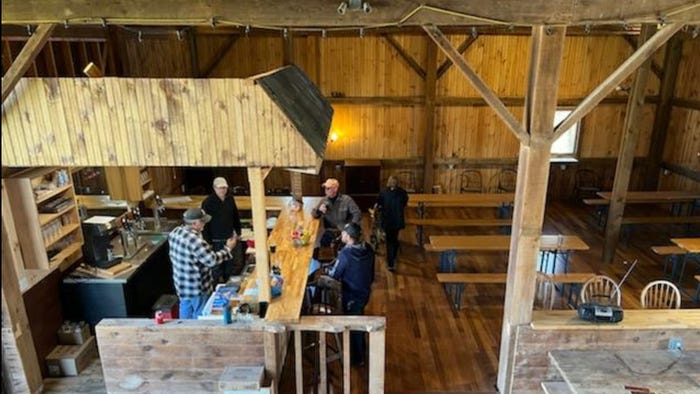June 5, 2023

Photos courtesy of Deborah Jeanne Sergeant
When Rick Fernandes bought an 1850s farmhouse and Pennsylvania Dutch-style gambrel barn in 2001, he knew he had a big job on his hands.
The barn, featuring a drive-up front and walk-out back, was once run by the McBride family of Oswego, N.Y., who ran a dairy and cheesemaking operation on-site and sold cheese locally. During the 1970s, the owners operated a nursery on the farm.
But the barn had fallen into disrepair with a large hole in the roof. As with any structure with a bad roof, this is the first job to tackle. Once a roof goes, the rest of the building goes with it, and Fernandes could not bear seeing the post-and-beam barn go.
It took two summers to repair the roof, he says, as he worked on it on the side in addition to his job in construction.
As money allowed, he continued working on refurbishing the barn.
Then, in 2017, the farmhouse burned. Undeterred, Fernandes kept working on the outer shell of the barn.
“All the post and beams and framing lumber is original,” he says. “The basement where the cows were was the old trough mixture of concrete and dirt. I cleaned it all up and put a concrete floor in it six years ago.
“It's been a long project. Farmers leave a lot of stuff behind. The property needed time to get fixed,” he adds.
Three years ago, Fernandes retired and decided to turn the barn into a brewery, mostly because of incentives he got through the state’s farm distillery and brewery program. Fernandes was never a farmer, but he already was a home beer brewer, so brewing seemed the right fit for the old barn.
“Cheese was another alternative, but we were working in Georgia, and no one down there makes cheese, so I couldn’t learn that,” he says. “So, I learned how to make beer.”
New life as a brewery
Home brewing is one thing. But Fernandes says he needed to learn the ropes of commercial brewing.
He liked the barn’s wide-open interior, measuring 1,960 square feet.
“When you walk in, it’s a big space with high ceilings and the hayloft,” he says. “It seemed like a very comfortable place.”
He also liked the fruit trees on the property, left over from its days as a working farm. It allows customers a relaxing place to unwind with a brew.
But before he could welcome guests, he had to put in a septic system, plumbing and electrical hookup. Fernandes hired professionals for some tasks as he did not want to damage the structure.
The height of the barn was also challenging.
“It’s difficult to get to without spending a lot of time building scaffolding,” he says. “I had some help doing the electrical work. I have basic wiring skills. But I had a licensed electrician do that work. We had an architect do some basic drawings and evaluate it for its use.”
He also had to make the space suitable for public use, such as ensuring it is handicapped accessible.
He invested close to $100,000 into the project, not including labor and brewery equipment. As he provided most of his own labor and repurposed lumber from other projects, this helped keep costs down. The reused lumber also lends a rustic look that fits the barn.
“There’s a lot of stuff in here, like the nursery left galvanized piping that I repurposed as a bar footstool,” he says. “The old kitchen cabinets in the farmhouse I used to make cabinets in the taphouse. In the past, I used the pressure-treated lumber from the nursery to make a scaffold for the high work. We left the original flooring exposed.”
The tack room area became the bathrooms, and Fernandes kept some of the original wood. He also used antique hardwood door handles.
Fernandes makes about 60 barrels of beer annually. He sources most of his ingredients from local suppliers as part of the New York Farm Brewery requirements.
Fernandes and his wife, Dawn, welcome guests to Junco Brewing Co. seasonally.
Sergeant writes from central New York.
Read more about:
HopsAbout the Author(s)
You May Also Like




